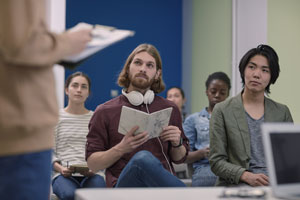 IEEE Biometrics Council has introduced the Distinguished Lecturers Program (DLP) to support education related activities for the biometrics community. The purpose of DLP is to increase awareness about topics relevant to Biometrics by creating a pool of leading experts who are willing to speak in meetings hosted by IEEE Chapters and Sections. To organize a distinguished lecture, please read the guidelines and submit a completed DLP Speaker Request Form.
IEEE Biometrics Council has introduced the Distinguished Lecturers Program (DLP) to support education related activities for the biometrics community. The purpose of DLP is to increase awareness about topics relevant to Biometrics by creating a pool of leading experts who are willing to speak in meetings hosted by IEEE Chapters and Sections. To organize a distinguished lecture, please read the guidelines and submit a completed DLP Speaker Request Form.DLP Chair

DLP Speakers


This presentation summarizes my three decades of research in fingerprint recognition and other biometrics. It begins with our early work on minutiae extraction and matching, followed by a review of the Fingerprint Verification Competitions (FVC) and their impact. It covers synthetic fingerprint generation via SFinGe, including process and validation. Additionally, it discusses double-identity biometrics like face morphing and creating double-identity fingerprints. Finally, the presentation examines the shift to deep learning and generative AI, comparing classical methods with deep learning, and addresses continual learning and large language models.
In this talk I will share our experience on online continual learning, focusing on practical computer vision applications. In particular, I will show that deep learning models can be trained on edge devices in near real-time starting from short videos. Some computationally efficient approaches will be introduced and hints will be given on how they can control forgetting and work with small non-i.d.d. batches (even rehearsal free). A latent replay approach will be then introduced and proved to be a good tradeoff between accuracy/efficiency and storage. Finally generative latent replay is discussed by proving some pointers to our current and future work.


Lessons from high-profile cases and how to design safeguards for responsible deployment.
How image quality and demographic factors shape recognition performance in real-world systems.


Over the years, automated fingerprint recognition has evolved into a dependable method for human authentication, through decades of research and development. The shift towards contactless fingerprint acquisition is driven by its enhanced user convenience, superior hygiene, and the elimination of residual impressions. Emerging contactless fingerprint technologies enable deformation free and hygienic acquisition of ground truth finger ridge-valley details but pose new challenges for accurately matching with respective contact-based fingerprint images, billions of which are available in various government databases. In this presentation, I will explore the recent advancements in contactless fingerprint identification technologies and share some of our findings. We will also discuss on the technical challenges that are limiting the deployment of emerging contactless 3D fingerprint technologies and further research on the contactless fingerprint technologies.
Human hands are easier to present, convenient to image, and can reveal a multitude of features under various lighting conditions and across a broad spectrum of imaging resolutions. Beyond fingerprint characteristics, attributes such as palmprints, finger knuckles, and hand geometry captured under visible illumination, as well as palm- and finger-vein features obtained through near-infrared and far-infrared imaging, have garnered significant interest from researchers and developers for real-world applications. The development of such advanced AI techniques to accurately and securely match such biometric patterns is also critical for a range of fintech and metaverse applications. This talk will explore cutting-edge advancements in hand-based biometric systems and highlight the gap between lab-grade accuracy and the messy reality of everyday use. Join a journey into the future of identity—where the hand isn’t just a tool, but a key to unlocking secure, borderless innovation.

Self-supervised learning is attracting a lot of attention in the research community because of its advantages over supervised learning in the context of building AI foundation models. These advantages include no cost of data annotation, avoidance of the negative impact of misleading information provided by coarse labels, the need for smaller training sets to facilitate learning, and the ability to model the data properties more directly. Self-supervised learning is accomplished by different pretext tasks, which are formulated in terms of appropriate objective functions. The learning methods themselves are based on a range of heuristics, such as distillation, temperature, asymmetry, batch normalisation, etc. The talk will discuss these heuristics by revisiting the problem of unsupervised learning based on the Gaussian mixture model estimation in the input data space. The parallel with clustering in the original space will motivate a novel approach for self-supervised learning in the embedding space. The merits of the proposed approach will be demonstrated on a range of experiments producing very promising results.
The training methods in AI do involve semantically distinct pairs of samples. However, their role typically is to enhance the between class separability. The actual notion of similarity is normally learned from semantically identical pairs. In this talk we shall discuss a new paradigm of learning introduced by Wu et al (arXiv:2410.18200), which explores the possibility of learning similarity from semantically distinct sample pairs. The approach is motivated by the observation that for any pair of classes there exists a subspace in which semantically distinct samples exhibit similarity. This phenomenon can be exploited for a novel method of learning, which optimises the similarity of an arbitrary pair of samples, while simultaneously learning the enabling subspace. The feasibility of the approach will be demonstrated experimentally and its merits discussed.
The recent huge strides in Artificial Intelligence (AI), thanks to advances in sensors, information and communication technologies, and most importantly, in neural network architectures and deep learning, have opened new opportunities in diverse fields of AI application. However, AI systems, by their nature, are complex, and autonomous, and, as such, they can not be deployed robustly without comprehensive anomaly detection capabilities, which are essential for correct handling of unexpected situations and anomalies. We address the problem of anomaly detection by reviewing the classical approach to flagging unexpected data and situations, based on modelling normality, and detecting outliers of the model distribution. A critique of this simplistic approach will identify other mechanisms, that modern anomaly detectors should incorporate, to detect anomalies and their nuances, so as to gain a better understanding of the cause of deviation from normality, and guide any corrective action as a result. We describe an anomaly detection system designed in response to the criticisms. In addition to the standard outlier detection module, its architecture includes a classifier incongruence detector, decision confidence assessment module, data drift monitoring subsystem, data quality analysis, and a reasoning module, that analyses the cues generated by these subsystems. Some of these mechanisms, such as classifier incongruence detection, will be discussed in more detail. A few examples of application of these complementary mechanisms will be presented. It will be emphasised that these are just discrete attempts to contribute to the research and development needed to tackle effectively this important prerequisite of AI deployment.
Self-supervised learning (SSL) is recognized as an essential tool for building foundation models for Artificial Intelligence applications. The advances in self-supervised learning have been made thanks to vigorous arguments about the principles of self-supervised learning and through extensive empirical research. The aim of this paper is to contribute to the development of the underpinning theory of self-supervised learning, focusing on the deep clustering approach. We formulate the learning problem as K-L divergence optimization, which leads to self-distillation, with updates for the student and the teacher network grounded in principled mathematical arguments. This leads to a novel method of teacher distribution normalization using inverse cluster priors. We show that using Jensen inequality this normalization simplifies to the popular batch centering procedure. We also derive the conditions for stable learning, which can be satisfied either using differential temperature for the student and teacher, or with the help of judicious data augmentation strategies. These are common practices in SSL, but our theoretical underpinning explains them within a single framework. The theoretical model developed not only supports existing successful SSL methods, but also suggests directions for future investigations which would further enhance the understanding of the SSL process, as well as beneficially impacting on its outcome.


Previous DLP Chair (2022 – 2024)
-
Terry Boult, University of Colorado, USA
Previous DLP Speakers (2022 – 2024)
-
Joseph Bigun, Halmstad University, Sweden
-
Kevin W. Bowyer, University of Notre Dame, USA
-
Mark Nixon, University of Southampton, UK
-
Sharath Pankanti, Microsoft, USA
-
Venu Govindaraju, University at Buffalo, SUNY, USA
-
Xilin Chen, Institute of Computing Technology, Chinese Academy of Sciences, Beijing, China
-
Yasushi Yagi, Osaka University, Japan



